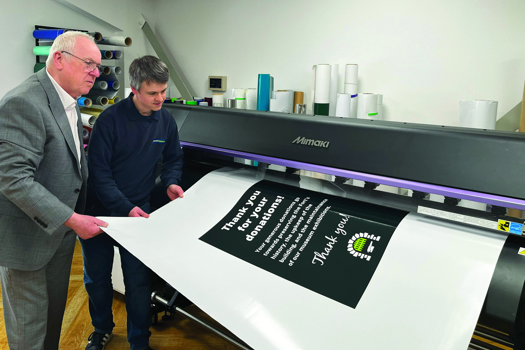The day, which is marked globally on 8 March, aims to celebrate the social, economic, cultural and political achievements of women. It also marks a call to action for accelerating gender parity.
Explaining the #BreakTheBias theme, IWD stated: “Whether deliberate or unconscious, bias makes it difficult for women to move ahead. Knowing that bias exists isn’t enough, action is needed to level the playing field.”
It has called on individuals to actively call out gender bias, discrimination and stereotyping each time they see it.
A 2019 report from the BPIF found that the UK print industry was at the time made up of 69% men and 31% women, with women less likely to have production roles, and there was a large pay gap between genders.
However, advances in technology and the increased trend of flexible working that has been speeded up by the coronavirus pandemic have arguably both helped to increase and diversify the roles and opportunities available in print for women.
A selection of women from across the industry shared their thoughts on International Women’s Day:
Alison Branch, managing director, Park Communications
“With what is going on in Ukraine at the moment, I have to start by recognising the tremendous bravery of the women, and men, of Ukraine. It is truly humbling to hear of a woman who took her children out of the country to safety, and then went back to the war zone because she is a critical member of the team at the power station supplying electricity to her city.
“From my experience, the lower percentage of women in the industry has been as much because of the physicality of many of the roles, as it has been because of any long held perception of what constitutes ‘a man’s job’. There is no doubt that you need muscles to lift and handle large volumes of B1 sized paper, but technology has taken away much of the need for heavy lifting.
“In addition, much of the dirt and grease in the working environment, which might be off-putting to some women has also been removed. Pre-press, IT, administration and digital printing immediately come to mind as areas where the physical demands are reduced, and where women should see no limits. For the women who carry out the majority of childcaring and domestic management duties, the flexibility of hours and partial home working introduced through Covid has brought even more encouragement to join our industry.
“I do not recall ever facing gender bias. As long as you know your subject, my experience is that a woman will be treated as equal. The shortage of women in senior management positions is more a reflection of the lower percentage of women in the industry, than any issue of prejudice. As more women are coming into the industry, more are reaching the top. Print is no different from any other area – having a gender balanced team can only be good.”
Karen Herbert, operations director, Eight Days a Week Print Solutions
“In my 36 years of print the workplace is definitely very different to it was when I first started. Over the years I have seen an increase of women in both senior and production roles rather than just the admin roles which were typically the only roles available. There is still work to be done to get to full equality, we need to increase the number of younger women coming into the industry as it is still seen as a career for men.
“I think Covid and remote working has certainly helped or will help future women in the industry as it has been proven now that working from home and balancing family life can work, it opens up a pool of talented women that the industry would have discounted previously.”
Rachael Hunt, head of marketing and business development, Visual Print & Design
“Although print is considered a male-dominated industry, I do think there are many opportunities for women to grow and thrive within it, and I would consider it an inclusive industry. Due to both the pandemic and the impact of technology, the print industry has expanded and diversified so much in the last two years, and we need to ensure we adapt our working practices where possible to ensure we attract the best talent, whatever their gender.
“While we need to attract more women into print roles, what we also need to do now is entice younger people into the print industry. The pandemic has meant many potential and skilful people have been lost due to print businesses going under and we need to find those people again. We need to invest in more apprenticeships, demonstrate why it is an attractive career path and inspire the next generation of print workers.
“While technology – and the pandemic – has made flexible working easier, let women regain control over their time and manage work and home-care responsibilities, I'm not sure [technology] has opened up more opportunities for women with children. What it has demonstrated is that childcare continues to fall upon women with many having to juggle responsibilities, potentially holding back their careers.
“I believe that until the UK government makes parental leave flexible and open to utilisation by either parent – like so many European countries already do – women will always be the default 'caregiver' and no advancement in technology will change that.
“This year’s International Women’s Day is all about creating a world free of bias, stereotypes and discrimination but sadly, we still have a long way to go to make that happen.”
Zenna Parfaniuk, managing director, The Label Makers
“We are getting better, but we still have a long way to go. It is up to us to ensure we break down some of the traditional barriers. The industry has been too set in its ways for far too long and could end up at crisis point with the ageing male dominant workforce. Women have the knowledge and skills to succeed when given the opportunities.
“I believe technology has opened up more opportunities for women. Traditional print is still very male orientated but there are no barriers for women working in area such as digital print. We are familiar with the technology used and no smoke screens of engineering etc to be bamboozled by. The impact of the pandemic has also seen us use technology in a better way, which allows a more flexible approach to working hours allowing women to work from home and still care for their families.”
Jackie Potter, finance director, Micropress
“The traditionally male-dominated printing industry can absolutely be considered a woman friendly workplace in my opinion. For all to agree with my view I do believe we need to break the bias and keep challenging the stereotypes.
“If you really think about it, what are the barriers to women working in printing? I can’t think of one. Women are more than capable. It is traditionally not an obvious career choice for women, but if we keep challenging the stereotype over time this can change.”
Dawn Reid, regional director, BPIF
“A big problem is perception due to our sector being a male-dominated one, much like most manufacturing. A lot has been done since I started in the industry to offer more flexibility in working hours, more diverse and accessible roles, and we are starting to see a difference. However, we need to continue to ensure we raise the awareness and visibility of women in our industry to break the bias.
“We need to create greater awareness of the opportunities and innovation in the industry to encourage more young people generally and more women in particular to join.”
Liz Smith, managing director, LG Davis
“As a woman in print I have found myself in the past at business conferences where I am the only woman in the room.
“A lot has been done more recently to change the gender gap and steps have been made in the right direction but in 2022 women are still very much underrepresented in senior management and executive roles.
“A lot has been done in recent years to offer more flexibility in working hours to make roles more accessible and we are starting to see a difference. However, numbers of women in the printing industry are and continue to be low.
“For me, as an industry we need to do more to raise awareness of what we offer. There is a real lack of awareness about print as an industry and I think that is why we are struggling. It is similar in other manufacturing and science, technology, engineering and mathematical (STEM) roles. There just isn’t enough information and promotion on the opportunities.
“I suppose it can be a more physical role with lifting reams of paper on to the machinery and also require longer working hours and shift patterns which might not be as appealing. However, as an industry we need to create more flexibility into roles if we are to change perceptions.
“As a business we are very passionate about offering flexible working hours and part-time roles to attract a diverse and varied workforce. As an industry more needs to be done to offer greater opportunities for potential employees who may struggle with longer or rigid shift patterns.”
Louise Stephenson, managing director, WTTB
“People still believe the age-old myth that the print industry is dominated by men, which is simply not true. The advances in technology have eliminated many of the boundaries that have shoehorned women into gender-stereotyped roles. In fact, we currently have more women working on the factory floor than men.
“With more women joining the industry, working in production and leadership roles, these role models continue to diminish outdated views in print and magnify the female platform.
“At WTTB, we see people for their skill set, which means we employ the right person for the role, regardless of gender, ethnicity and sexuality, making our workplace inclusive and welcoming to everyone.
“So what does this mean for the future of the trade? Only time will tell. But one thing is for sure – more women are working in print than ever, and as a female managing director working in this male-led industry, it's truly momentous to see!”
International Men’s Day, an annual celebration to recognise and celebrate the achievements of men, will take place on 19 November.










